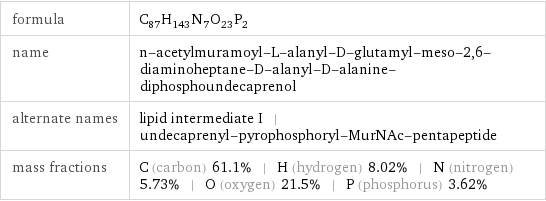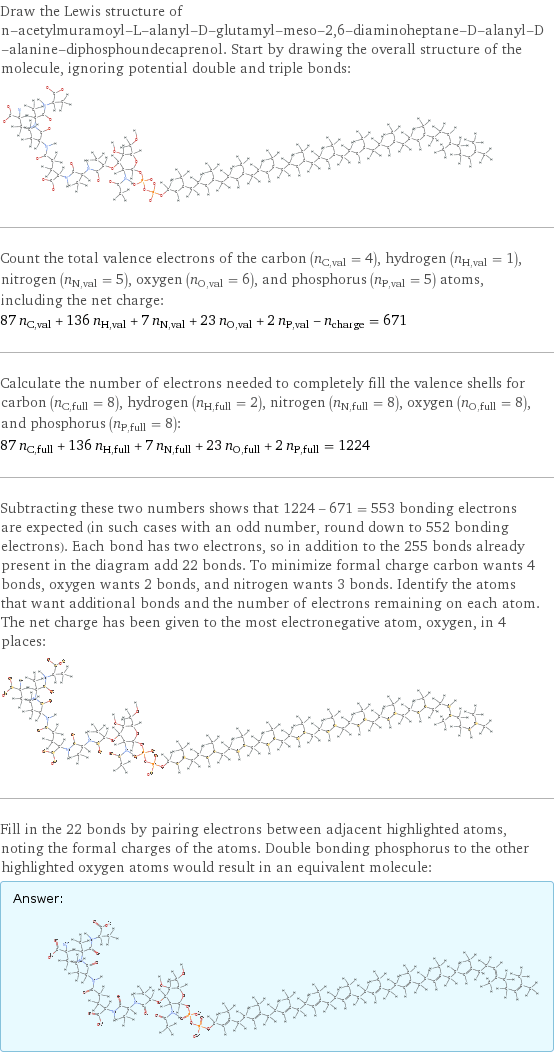Input interpretation

n-acetylmuramoyl-L-alanyl-D-glutamyl-meso-2, 6-diaminoheptane-D-alanyl-D-alanine-diphosphoundecaprenol
Chemical names and formulas

formula | C_87H_143N_7O_23P_2 name | n-acetylmuramoyl-L-alanyl-D-glutamyl-meso-2, 6-diaminoheptane-D-alanyl-D-alanine-diphosphoundecaprenol alternate names | lipid intermediate I | undecaprenyl-pyrophosphoryl-MurNAc-pentapeptide mass fractions | C (carbon) 61.1% | H (hydrogen) 8.02% | N (nitrogen) 5.73% | O (oxygen) 21.5% | P (phosphorus) 3.62%
Lewis structure

Draw the Lewis structure of n-acetylmuramoyl-L-alanyl-D-glutamyl-meso-2, 6-diaminoheptane-D-alanyl-D-alanine-diphosphoundecaprenol. Start by drawing the overall structure of the molecule, ignoring potential double and triple bonds: Count the total valence electrons of the carbon (n_C, val = 4), hydrogen (n_H, val = 1), nitrogen (n_N, val = 5), oxygen (n_O, val = 6), and phosphorus (n_P, val = 5) atoms, including the net charge: 87 n_C, val + 136 n_H, val + 7 n_N, val + 23 n_O, val + 2 n_P, val - n_charge = 671 Calculate the number of electrons needed to completely fill the valence shells for carbon (n_C, full = 8), hydrogen (n_H, full = 2), nitrogen (n_N, full = 8), oxygen (n_O, full = 8), and phosphorus (n_P, full = 8): 87 n_C, full + 136 n_H, full + 7 n_N, full + 23 n_O, full + 2 n_P, full = 1224 Subtracting these two numbers shows that 1224 - 671 = 553 bonding electrons are expected (in such cases with an odd number, round down to 552 bonding electrons). Each bond has two electrons, so in addition to the 255 bonds already present in the diagram add 22 bonds. To minimize formal charge carbon wants 4 bonds, oxygen wants 2 bonds, and nitrogen wants 3 bonds. Identify the atoms that want additional bonds and the number of electrons remaining on each atom. The net charge has been given to the most electronegative atom, oxygen, in 4 places: Fill in the 22 bonds by pairing electrons between adjacent highlighted atoms, noting the formal charges of the atoms. Double bonding phosphorus to the other highlighted oxygen atoms would result in an equivalent molecule: Answer: | |
Basic properties

molar mass | 1710 g/mol
Units

Chemical identifiers
![PubChem CID number | 52940090 SMILES identifier | CC(C)=CCCC(C)=CCCC(C)=CCCC(=CCCC(=CCCC(=CCCC(C)=CCCC(=CCCC(=CCCC(=CCCC(=CCOP(OP([O-])(=O)OC1(C(NC(=O)C)C(OC(C)C(=O)NC(C)C(=O)NC(C(=O)[O-])CCC(=O)NC(CCCC([N+])C(=O)[O-])C(NC(C)C(=O)NC(C)C([O-])=O)=O)C(O)C(CO)O1))([O-])=O)C)C)C)C)C)C)C](../image_source/369b75da8d5c5dd575d09cf95d963650.png)
PubChem CID number | 52940090 SMILES identifier | CC(C)=CCCC(C)=CCCC(C)=CCCC(=CCCC(=CCCC(=CCCC(C)=CCCC(=CCCC(=CCCC(=CCCC(=CCOP(OP([O-])(=O)OC1(C(NC(=O)C)C(OC(C)C(=O)NC(C)C(=O)NC(C(=O)[O-])CCC(=O)NC(CCCC([N+])C(=O)[O-])C(NC(C)C(=O)NC(C)C([O-])=O)=O)C(O)C(CO)O1))([O-])=O)C)C)C)C)C)C)C